Heraklion, the capital of Crete with resemblance to Athens in many ways, is the largest of the five major cities in Crete.
The city is a charming combination of Venetian architecture, urban concrete constructions and street art, with the rich history providing its own twist to the city.
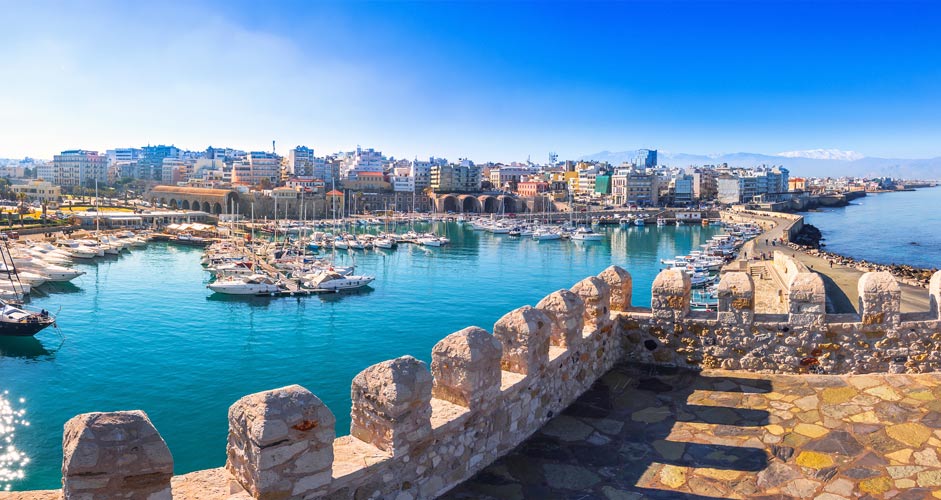
Where to stay
The wide selection of accommodation in Heraklion offers something for everyone's taste, with every star-class included. The choices range from large tourist resorts to small - medium-sized hotels, both in the center and outside of it. Locations away from the center include, for example, Ali Karnassos or the vicinity of the Ammoudara beach in Gaza.
There's also private accommodation available, such as apartments or rooms for rent. Budget-friendly accommodation can be tricky to find. There are a few hostels available, though, with the price range of 16 to 20 euros per night. Note, however, that the price per night varies greatly according to the season.
Attractions and things to do in Heraklion
Although small in size, the city is a vibrant and culturally rich metropolis with its colorful history evident around the city. Reconstructions after wars and its choice as an Olympic host city have been the main contributors to changing the city into what it is today.
In addition to a small but important airport, Heraklion has one of the most important ports of the island for cruises, exports and imports. Thus, the city is regarded as a major hub with regard to transportation.
It is also the hometown of Nikos Kazantzakis, a prominent writer of contemporary Greek literature. Also, the world-famous painter, El Greco, was Cretan.
Heraklion is best suited for a city break of a few days, for exploring the rich history of both the city and Crete. The island was the home of the first civilization in Europe, with the Minoan culture influencing the Aegean Sea from 3100 to 1100 BC. During the era, the fabulous city of Knossos on the outskirts of Heraklion served as the capital of the nation.
Koules Fortress
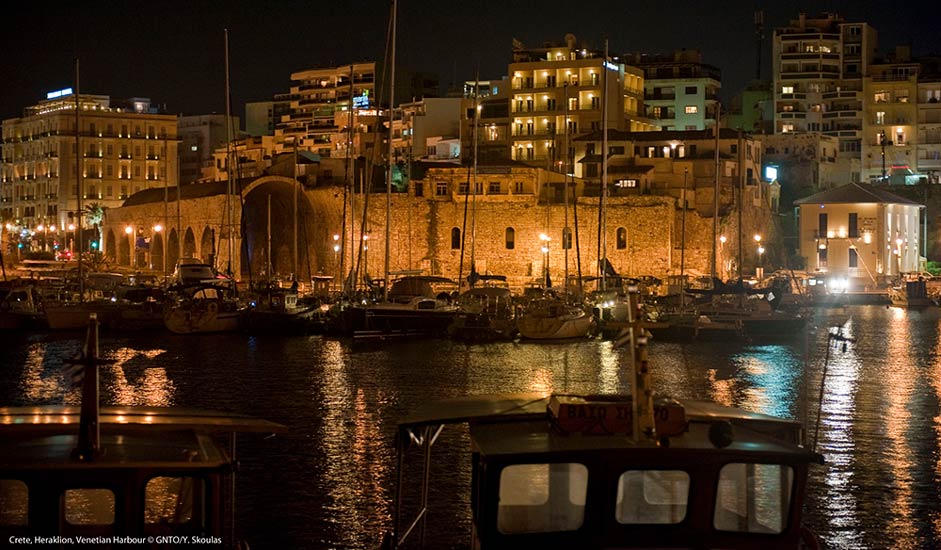
The current form of this fortress is reminiscent of the Venetian era. However, it has also served as a prison, among other things, under the rule of the Ottoman Empire. The fortress and its breakwaters surround the current harbor. The fortress ends with a three-kilometer-long breakwater, which especially in the evenings provides a romantic setting to watch the ships leaving the harbor. It is popular among locals for evening walks, fishing and jogging.
The fortress itself is open for visitors with opening hours varying according to the season. During the high season, there are cultural events in the fortress - the weather permitting. The entrance ticket costs only a few euros. In given areas, the fortress may not be suitable for disabled visitors. Koules is within walking distance of the city center.
Adjacent to Koules, there's a section of the old Venetian harbor, with traditional, colorful fishing boats in the midst of modern boats. The port also serves as a small-boat-marina. Opposite to the Koules fortress, next to the old Venetian harbor and a highway, there are old shipyards that are open for a visit.
Morozini, Liontaria - The Lions Square
The square is the city's central point, which dominates the entire city center and the nearby landmarks. It is within walking distance of the key sites, such as KTEL and the Koules Fortress.
The square is a popular and busy meeting place for locals and tourists alike. The unofficial name ‘Liontaria’ originates from the four lions carved into the fountain. The square is surrounded by numerous cafes and restaurants linking the busiest promenades of the city together. As the streets are closed to traffic, it is a great resting place in the midst of sightseeing and shopping.
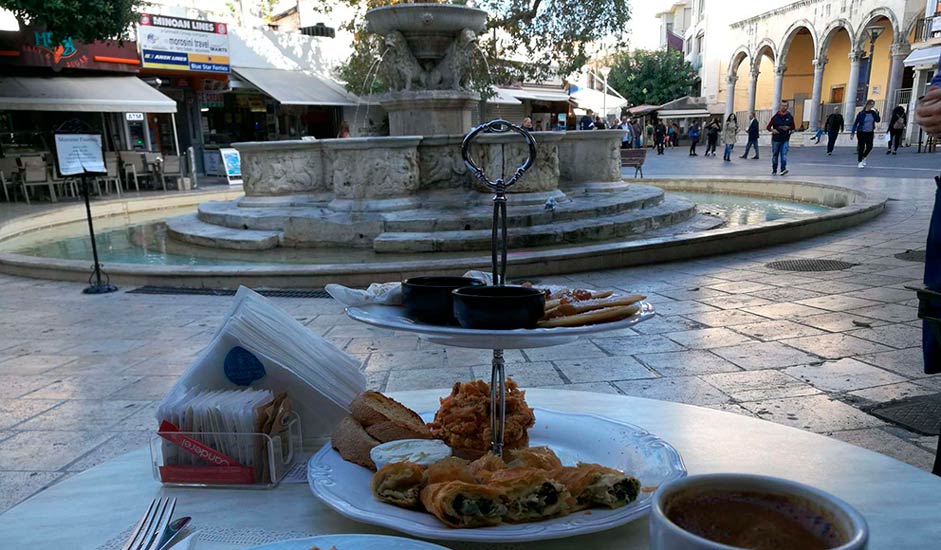
The Basilica of St. Mark, now an art gallery, is situated a stone’s throw away from square. This important building representing Venetian architecture features works by local artists as well as historical artifacts. In addition, there are events and sometimes small markets.
Behind the art gallery, there's another Venetian landmark, Loggia, which is part of the Heraklion City Hall. Both buildings are popular with young people and locals, especially in the evenings.
The church of Agios Titos and its squares are situated less than two hundred meters from Loggia. The church is worth visiting, even if you are not a very religious person. It is also surrounded by numerous cafés and restaurants offering a busy nightlife, especially on weekends.
The church is located at the beginning of the city’s most famous street, the 25th of August Street, which is also considered one of the most beautiful streets in the city. It leads to the sea, thus providing a direct walking connection to the old port and the Koules fortress. The August Street is named after the Cretan War of Independence.
Plateia Eleftherias
The Eleftherias square may not be architecturally significant, but just like the Lion Square, it’s a landmark that connects many important sites and shopping streets of the city.
Eleftherias is a spacious asphalt-paved urban area, which also serves the purpose of a roundabout. In addition, it's an easy location to grab local buses to travel all across Heraklion, to places and city areas such as Knossos and Nea Alikarnassos, respectively.
Here, just sit for a moment and follow the pace of the city - unless there's an organized event of some kind taking place. For example, at Christmas and almost all of December, the square packed with stalls. It is also a popular venue for young people and locals to meet and hang out.
Also nearby, there's the statue of the great Elefterios Venizelos (a Cretan-born politician) who once united the island of Crete to Mainland Greece. The statue and the surrounding squares are overlooking the current city port and the sea.
Opposite to the square, there's a park called Georgiadi, which is somewhat reminiscent of the National Park of Athens. Georgiadi is located at the very center and serves as the lungs of the city. It is much smaller and less organized than the National Park of Athens. Currently, the Georgiadi park is partially closed due to renovations.
Knossos
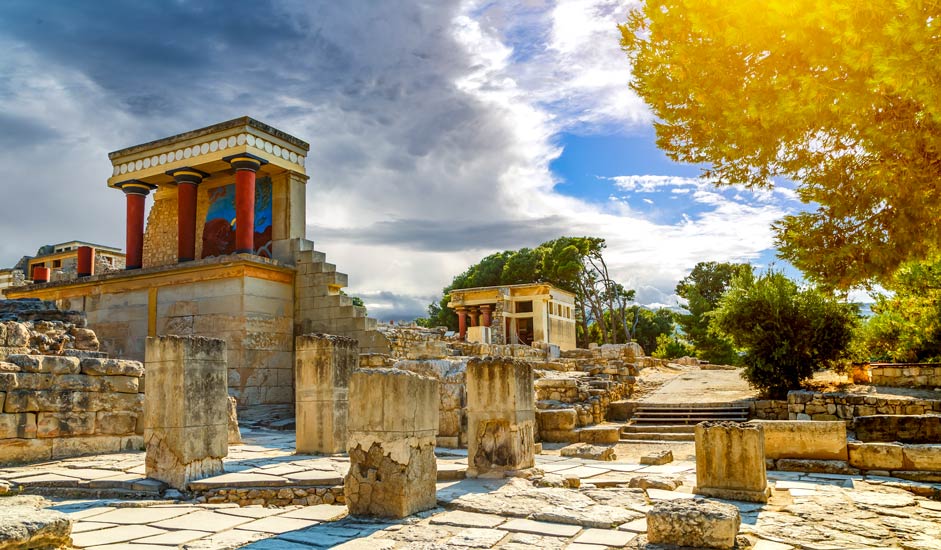
To get directly from the city to Knossos, the center of Minoan and Mycenaean culture, use the bus number 2. The journey takes twenty minutes and costs a few euros. The palace and its ruins have been partially reconstructed again.
Read here for more information on ticket prices and opening hours for both Knossos and the Archaeological Museum. Tickets for Knossos and the Archaeological Museum can also be purchased online here.
The City Walls and the tomb of Nikos Kazantzakis
Heraklion is surrounded by walls, the construction of which began in the Middle Ages. Originally, the purpose of the walls was to protect the city against enemies from the sea, whereas today, you can walk upon them, visit the various bastions they conceal, and enjoy the view to the city instead.
The walls also provide access to the tomb of Nikos Kazantzakis, which is located in the Martinengo bastion near the center. Born in Heraklion, this contemporary writer, poet, philosopher and playwright is undoubtedly still one of the most famous Greeks worldwide.
The Nikos Kazantzakis Museum is situated fifteen kilometers south of the city in a village called Myrtia, which can be reached by car, taxi or bus.
Agios Minas Cathedral
Agios Minas, the largest cathedral of Crete, is located at the heart of the city center, near the Kornarou Square. The square also contains the Bombai Fountain, which serves as the entrance to one of the busiest shopping streets of the city.
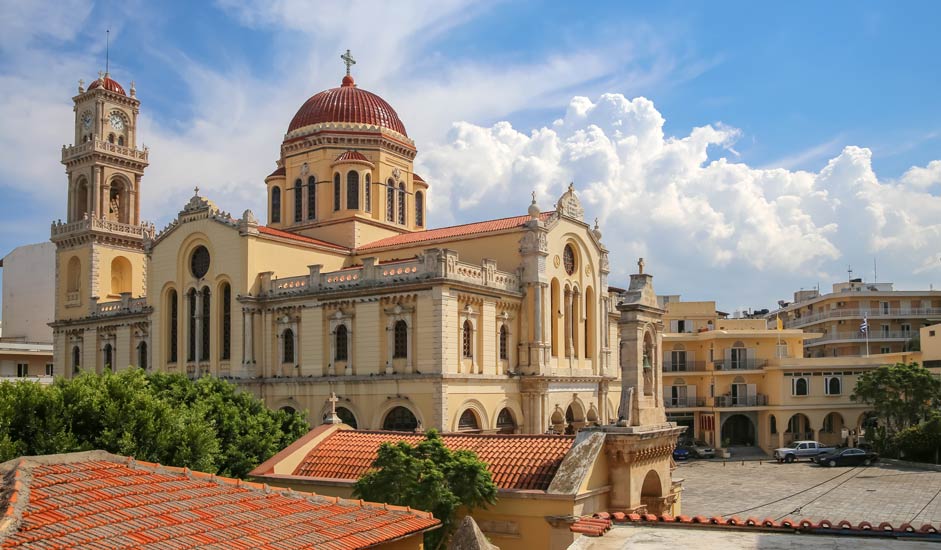
Less than a five-minute walk from the cathedral, there's the Agia Ekaterini church, which once served as a university with prominent philosophers, writers and artists of its time, such as the painter El Greco, having studied there. Today, the building also serves as a museum, where visitors can admire rare icons and frescoes.
Near the cathedral on the other side of the Kalokerinou street, in the Agia Triada district, there's the oldest Armenian church within Europe. This is also the begin for a ragged and forgotten area, stretching all the way to the Priuli Fountain. The district and its streets have their own atmosphere, which is hard to put into words. It is perfect for an occasional walk, as it provides a completely different urban atmosphere.
Although the area is adjacent to the city center, squeezed by the main streets and the highway along the beach, the ambient feeling is nonetheless tranquility. Street art lovers and people looking for beautiful details are very likely to enjoy themselves in the area.
Heraklion Archaeological Museum
The Heraklion Archaeological Museum is one of the most important museums in Greece and throughout Europe, containing an extensive collection of Minoan art, jewelry and relics from the Neolithic period. In short, it covers history dating back 5,500 years. In addition, the mysterious disc of Phaistos is available for a closer look in the museum. The museum is open both in high season and in winter, i.e. tourist-friendly all year round.
Activities for families
Natural History Museum of Crete
The museum, which is unique in Crete and the entire Mediterranean both in terms of its size and content, operates in partnership with the university. The museum is a great place to visit for families with children and basically for anyone who's interested in animals, fossils, dinosaurs and nature. In addition, the museum has an earthquake simulator. The museum is open all year round. For more details on opening hours and entrance tickets, check the following link.
Walking along the seaside boulevard
The seaside boulevard starts next to the Koules Fortress and continues to the Pankritio Stadium. On the boardwalk, there are various vantage points, urban roughness with graffiti, monuments, small parks, waterfront, a dog park, a children’s playground, a small area for skaters, as well as restaurants and cafes here and there. Although there's a highway right next to it, it’s easy to be captivated by the magnificent ocean. The Natural History Museum is also located along the boulevard.
However, it is worth noting that, especially in summer, the boulevard is exposed to sunshine constantly, and you should protect yourself from being sunstruck. In summer, early evenings or mornings are the best time for having a walk, i.e. when it is not too hot or too cold.
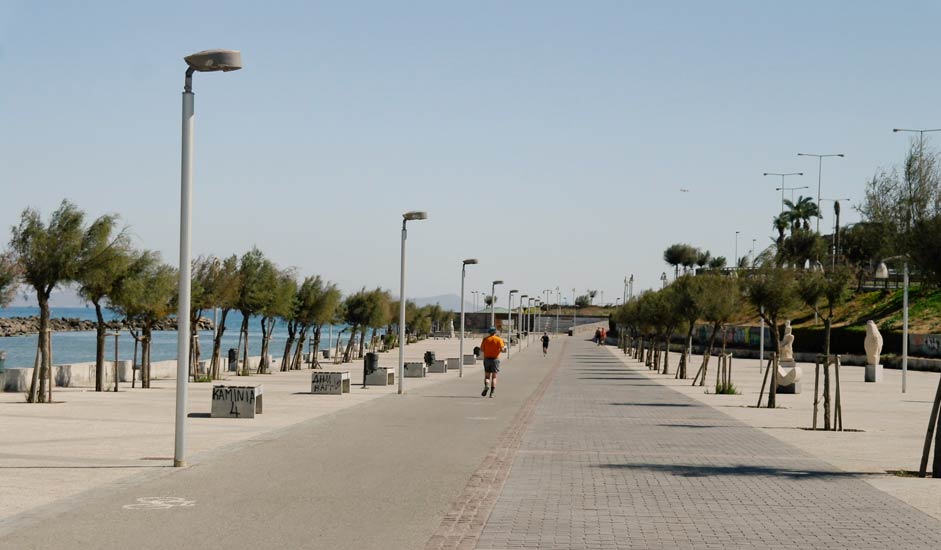
CretAquarium
This aquarium is especially well-suited for families with children. It is one of the largest aquariums in Greece and Europe with more than 2,500 different sea creatures to admire closely. The aquarium is situated just outside the city in the military area of Gournes.
If you don't have a car at your disposal, there’s a bus connection to the direction of Hersonnissos-Malia available. There is also a long, well-functioning sandy beach opposite to the building, so it is worth taking your swimming gear with you for the trip.
Read here for opening hours and prices
Heraklion beaches
The best method to travel in Crete is by car. Public transportation also works very well, but it doesn’t provide connections everywhere in the island. Having a car at your disposal gives better opportunities to explore the beaches and the mountains of the island.
With regard to holiday services, Heraklion and its surroundings are among the most developed areas in Crete. The entire coastline from Heraklion to Hersonissos and Malia, both of which belong to Heraklion, is packed with beaches and services of various levels.
Especially in high season, these destinations offer everything one expects an all-encompassing beach holiday to contain - for both good and bad. Malia and Hersonnissos are especially popular with young tourists due to their busy nightlife and well-kept beaches. If you want more than just a bass beat from your trip, you should head elsewhere.
Ammoudara

Ammoudara is a seven-kilometer-long sandy beach located near the town at the end of the seaside bouluvard by the Pankritio Stadium. The beach begins at the river Giofyros and ends westward at the river Almyros and the surrounding wet wasteland bearing the same name. Ammoudara is a “Blue flagged” beach, which ensures that the beach has clear water, is well maintained and offers services such as sun loungers, restaurants and water sports. Almost covering the entire length of the Ammoudara coastline, there's a rocky strip reminiscent of an ancient coastline at a depth of about fifty meters.
Westward from the Almyros River along the coastline, Ammoudara changes into the Ellinoperamata beach. Compared to Ammoudara, the Ellinoperamata beach is less popular and thus more quiet due to the nearby power plant and industrial area. The beach is open and windy and therefore popular with windsurfers, though. Like Ammoudara, Ellinoperamata can be reached by the blue line of the local bus service.
Karteros/Florida
Karteros is situated about seven kilometers east of Heraklion. This open bay has received its nickname "Florida" from an old restaurant, which, however, no longer exists. The beach is shallow consisting of fine sand. The nearby services range from food and accommodation to water sports. Conveniently, there's a local bus connection to the beach.
Matala
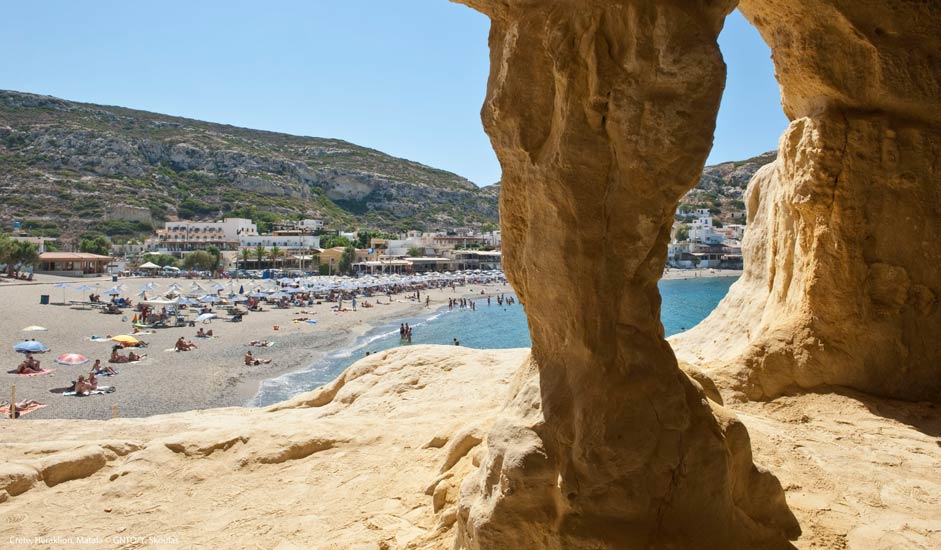
This beach, which is also referred to as a hippie beach, is situated 68 kilometers from Heraklion to the southwest along the coast. It is also famous for its caves, clear waters and the Matala Festival in June. Nearby, there's another Minoan cultural center, Phaistos, where the famous clay disc was discovered. There are bus connections to both Matala and Phaistos –tickets for adults cost about 8,5 euros, and the duration is less than 2 hours.
Food and restaurants
Food
Cretan food is traditional, versatile, healthy, fresh and tasty. Cretan cuisine and its high quality are known both internationally and among the Greeks. Not for no reason is the Cretan kitchen considered an ideal diet.
It includes plenty of vegetables, fruits, olive oil, cereals (barley and rye), legumes, goat and sheep milk cheese, yoghurt, honey, and a wide variety of seasonal products, such as wintertime and springtime wild vegetables.
Of the cheeses, feta is probably familiar to everyone even without having visited the country. Some of the most typical cheeses you are sure to come across are kefalotiri - a hard cheese made mainly from goat milk. Moreover, Graviera is a classic Cretan cheese made of sheep milk.
Saganaki, a baked fried cheese that is a classic meze, is mostly made of either goat or sheep milk - it can also be made of halloumi or feta, though.
Mizithra is a cream cheese made of goat or sheep milk, or both. It is often used as a filling for Kaltsounias, which are delicious Greek pastries especially enjoyed at Easter, which are nevertheless available all year round. Mizithropita is at its best with honey.
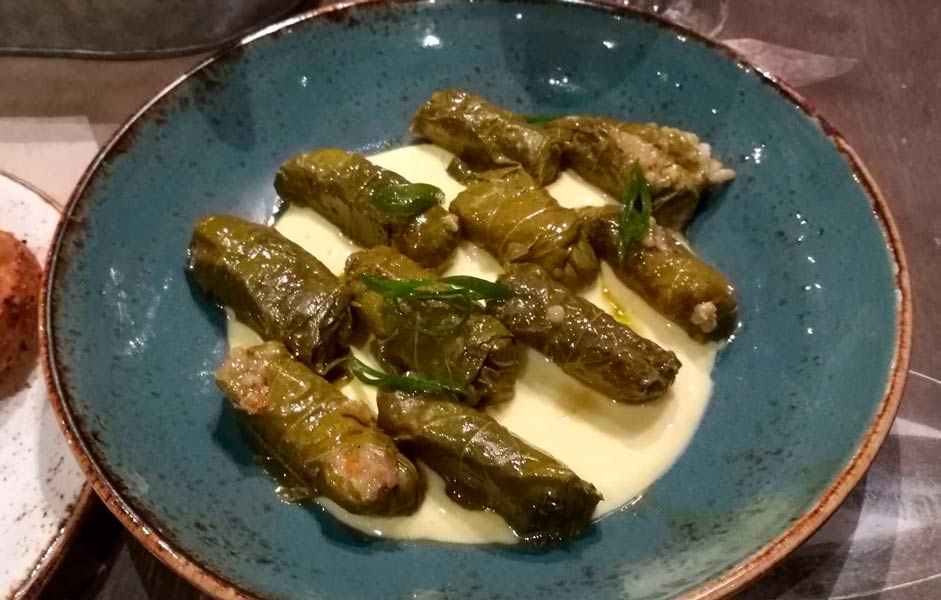
Of the various bean and lentil dishes, Fasolada, a soup made of white beans, and black-eyed bean soup, fasolakia mavromatika me maratho, are traditional Cretan dishes worth trying. If your holiday coincides with Easter, you should definitely try the traditional Easter soup, magiritsa, made of rice and lamb entrails.
Stuffed, oven roasted vegetables, gemista, and traditional meatballs, keftedes, are also delicious dishes that won't let you down. The same holds true for what is known as yuvarlakia, a tasty meatball soup.
There is also a lot of fish and other seafood on offer. Octopus, shrimp, swordfish and a fish soup, called Soupa kokkinopsaro, are tasty options. However, eating fish is surprisingly expensive, despite the fact that Crete is an island with fishing one of the main industries. This is due to overfishing, which has an impact on the price of fish.
Rabbit is a popular food, and there are dozens of different recipes served with both rice and potatoes. Rabbit is called kouneli in Greek, and usually is refers to bred rabbits. Lagos, on the other hand, refers to hunted hare, which is a little more challenging to find. Restaurants are the easiest way to find various dishes, such as rabbit fried in a pan (kouneli tiganisto), rabbit stewed in wine (kouneli kokkinisto) or fried hare (kouneli stifado).
If you want something a little more exotic, you might want to try snails (cochlioi), of which there are different alternatives available.
Traditional gamopilafo is made from goat meat served with rice, offering an authentic culinary experience. Even though this delicacy is a common wedding dish, it is also served in restaurants.
Lamb is also an essential part of Cretan cuisine. Lamb with lemon flavored potatoes is definitely worth trying - Arni lemonato ston fourno tastes sensational.
Restaurants
In Heraklion, there are plenty of restaurants along the seaside boulevard - they are mainly aimed at tourists. The Lions Square has a good selection for gyros dishes. On the outskirts of Plateia Eleftherias, there are restaurants that are popular with locals and tourists alike.
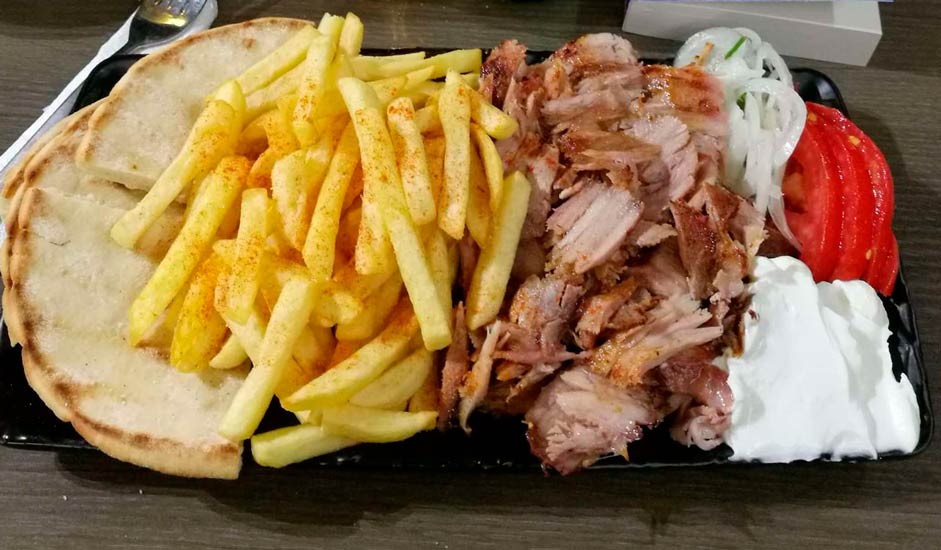
It's easy to get disoriented on the side streets behind Agios Tito, as the area is packed with restaurants and bars, some of which are only open in the evening.
Try restaurants that are seemingly popular with locals and taste different mezes or traditional ntakos, which consists of dried barley bread with tomato, oil and feta and is served with raki or wine.
Regarding mezes, many restaurants offer variation to choose from, but the selection often contains seasonal product. Therefore, don’t be surprised if you find snails on your plate in early spring, which are also popular with Cretans. Always ask the waiters for recommendations.
Drinks and nightlife
In general, the nightlife of Heraklion, with regard to beach parties and clubbing, is concentrated on Malia and Hersonissos. There are also some beach bars and club-like complexes, such as Envy and Edem, along the seaside boulevard in the direction of Pankritio Stadium and the few small shopping malls nearby.
Local firewater, Raki, also known as Tsikoudia, is produced by distilling the leftovers of a winemaking process. Its taste and intensity may vary significantly between regions and villages. Raki is a culturally important drink - it is more than just an intoxicating beverage - and drinking raki without eating is not appropriate.
Indeed, Cretans tend to say that the first glass evokes appetite, the second brings health, the third joy, the fourth happiness, the fifth excitement, the sixth chatter, the seventh the battle, the ninth the judge, and the tenth: the death.
Every traveler in Crete will sooner or later come across raki. Several places offer raki at the end of the meal to show kindness and hospitality. It can be thought of as a sign of Philoxenia, the Greek philosophy of hospitality and friendship to a stranger.
Raki is also served with sweet bites and seasonal fruits. Surprisingly, strawberries and raki, for instance, or raki and lukoumadeses, deep-fried doughnut-like balls, fit together in a captivating way.
Shopping in Heraklion
Most shops are located in the old town along car-free narrow pedestrian streets, such as the 1886 street. Here and on its side streets, there are shops for buying souvenirs, clothes, shoes, books, sheets, kitchen utensils, as well as more traditional products, such as raki, herbs, spices, sweets and leather goods.
The street is rather reminiscent of a covered market that starts at the Bembo Fountain and leads to the familiar center at the Lions Square.
Markets belong to the Greek culture, and there are markets being organized throughout the week in different parts of the city. The largest and best-known market is held on Saturdays in Pateles, lasting from morning till afternoon.
On offer, there are fresh vegetables and fruits directly from producers, fish, meat, olives, honey, utensils - and basically anything imaginable. Regardless of whether you need these products or not, the market itself is an experience worth having.
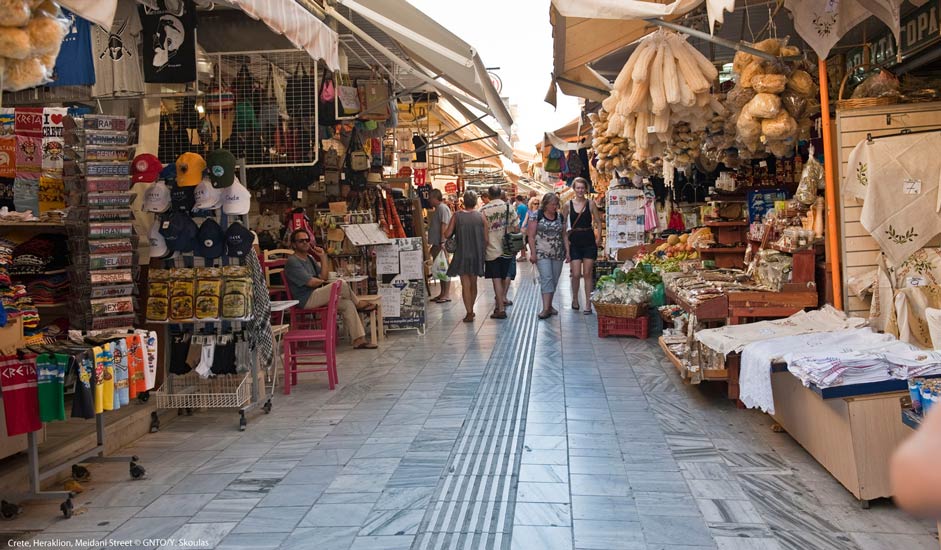
With regard to prices, bargaining is not typical in the markets. However, the grand total may drop a little, if you buy a lot of a given product or several different products at once. The busiest shopping streets in the city are the 1886 street, the 25th of August Street, the Dedalou Street and the Dikeosinis Street - all linked to the Lions Square.
The opening hours of shops and stores are also affected by the Siesta time, which is between about 3 p.m. and 5 p.m. You should take the siesta into consideration when planning shopping or even visiting a hairdresser. However, most of the largest grocery stores are open during this time as well.
The same applies to kiosks called peripteros, which mainly sell tobacco products, beverages, various foods as well as magazines. Peripteros have a well-established, strong social position in the Greek culture. It’s common to see people just spending time chatting with the kiosk keeper.
Prices in Heraklion
The price level in Heraklion is quite affordable compared to the average in EU countries. Things that are important for tourists, such as accommodation, food and drinks in restaurants, are also cheap. Hotel prices will rise towards the high season.
Below, there are some examples of restaurant and hotel prices in Chania. Costs of hotel rooms are median prices at Booking.com.
Pizza in restaurant
33 cl beer in restaurant
Hotel room, 3-4* (April)
Hotel room, 3-4* (July)
€9-12
€3
€83
€105
Transportation
There’s a good and efficient local transport system within the Heraklion area. Tickets can be purchased from buses or kiosks near bus stops. Timetables and bus routes are listed on the local transport website, or you can download the local transport application to your phone.
From the main bus station - KTEL - you can travel all across Crete at a relatively budget-friendly price. Timetables, tickets and prices can also be viewed and purchased online.
How to get to the center from Heraklion Airport
The international airport, named after Nikos Kazantzakis, is located some five kilometers outside the city. There are numerous options for getting to the city from the airport. Just outside the airport, there are both taxis (for about 20 euros) and a direct bus connection to the city (for a few euros). The journey from the airport to the city takes about 20-25 minutes.
From the airport, there are bus connections to the eastern parts of the island, for example, to Agios Nikolaos, Ierapetra or Sitia, but note that they leave from the other side of the street. However, to Rethymnon or Chania, first take a bus to the main Bus Station KTEL in the city center. The ticket can be bought directly from the bus, so do take some cash with you. In addition, there are numerous car rental companies outside the airport.
The current port of Heraklion is situated close to the famous Koules Fortress and the old Venetian port. Just like from the airport, it is easy to grab a taxi or bus from the port. The newly built bus station is less than a ten-minute walk away from the port. It's easy to navigate towards the center, or if you prefer, you can take a bus to other areas of the island.
From the port, there are also direct ferries to mainland Greece and other Greek islands, such as Santorini and Rhodes. Tickets can be purchased at the port from the stalls of the shipping companies, or via the comparison websites of the Minoan Lines, Seajets and Anek Lines connections. When traveling by boat, you should bear in mind the effects of seasonality on routes and schedules.
Comparison websites of ferry connections: Greek Ferries, FerryConnection
Weather and when to travel
The weather in Crete is good, and due to its location, mainly warm all year round. If you don’t enjoy scorching hot weather, you should avoid July and August and aim at seasons when it is not too hot nor cold. Such periods are early spring from April to June, or the autumn from September to late October - early November.
It's good to bear in mind that both locals and domestic tourist travel in August, and the same repeats at Easter in April. This should be considered when booking ferries and flights, for instance.
However, the island is well suited for traveling in winter as well. In fact, the nature is magically exotic in the wintertime. For many tourists, especially for those from northern Europe, the weather is still warm and the sea water refreshing.
However, as is typical for an island that is highly dependent on tourism, some places are already closed by then, and direct flights connections may not be easy to find. Therefore, the wintertime is best suited for self-guided trips. There are flight and ferry connections from mainland Greece to Chania and Heraklion available.
---
Text: Angela M.
Photos: Tuomas Hauhia, Adobe Stock & GNTO